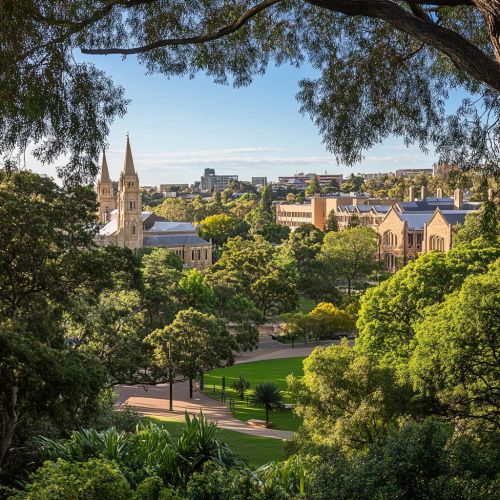University of Adelaide: Difference between revisions
No edit summary |
No edit summary |
||
| Line 9: | Line 9: | ||
The main campus of the University of Adelaide is located on North Terrace in the heart of Adelaide, South Australia. The campus is renowned for its blend of historic and modern architecture, with buildings such as the Mitchell Building, a prime example of Gothic Revival architecture, and the modern Braggs Building, which houses advanced research facilities. | The main campus of the University of Adelaide is located on North Terrace in the heart of Adelaide, South Australia. The campus is renowned for its blend of historic and modern architecture, with buildings such as the Mitchell Building, a prime example of Gothic Revival architecture, and the modern Braggs Building, which houses advanced research facilities. | ||
[[Image:Detail-99893.jpg|thumb|center|A picturesque view of the University of Adelaide's main campus, featuring historic and modern architecture amidst lush greenery.]] | [[Image:Detail-99893.jpg|thumb|center|A picturesque view of the University of Adelaide's main campus, featuring historic and modern architecture amidst lush greenery.|class=only_on_mobile]] | ||
[[Image:Detail-99894.jpg|thumb|center|A picturesque view of the University of Adelaide's main campus, featuring historic and modern architecture amidst lush greenery.|class=only_on_desktop]] | |||
The university also has additional campuses, including the Waite and Roseworthy campuses, which focus on agricultural and veterinary sciences, respectively. The Waite campus is home to the Waite Research Institute, one of the largest agricultural research centers in the Southern Hemisphere. | The university also has additional campuses, including the Waite and Roseworthy campuses, which focus on agricultural and veterinary sciences, respectively. The Waite campus is home to the Waite Research Institute, one of the largest agricultural research centers in the Southern Hemisphere. | ||
Latest revision as of 22:23, 2 November 2024
History
The University of Adelaide is one of Australia's oldest and most prestigious institutions of higher learning, established in 1874. It was the third university to be founded in Australia, following the University of Sydney and the University of Melbourne. The university was founded with a vision to provide education to a broad demographic, irrespective of background, and was the first in Australia to admit women to academic courses on an equal basis with men, a progressive step that underscored its commitment to equality and innovation in education.
Throughout its history, the University of Adelaide has been at the forefront of research and education, contributing significantly to the intellectual and cultural life of South Australia and beyond. The university has produced numerous Nobel laureates, including Howard Florey, who played a pivotal role in the development of penicillin, and J. M. Coetzee, a renowned author and literary critic.
Campus and Architecture
The main campus of the University of Adelaide is located on North Terrace in the heart of Adelaide, South Australia. The campus is renowned for its blend of historic and modern architecture, with buildings such as the Mitchell Building, a prime example of Gothic Revival architecture, and the modern Braggs Building, which houses advanced research facilities.


The university also has additional campuses, including the Waite and Roseworthy campuses, which focus on agricultural and veterinary sciences, respectively. The Waite campus is home to the Waite Research Institute, one of the largest agricultural research centers in the Southern Hemisphere.
Academic Structure
The University of Adelaide is organized into five faculties: the Faculty of Arts, the Faculty of Engineering, Computer and Mathematical Sciences, the Faculty of Health and Medical Sciences, the Faculty of the Professions, and the Faculty of Sciences. Each faculty comprises various schools and departments that offer undergraduate, postgraduate, and doctoral programs.
The university is renowned for its research output, particularly in areas such as biotechnology, environmental sciences, and engineering. It is a member of the Group of Eight, a coalition of leading Australian research-intensive universities, and is consistently ranked among the top universities globally.
Research and Innovation
Research at the University of Adelaide is driven by a commitment to addressing global challenges and advancing knowledge across disciplines. The university hosts several research institutes and centers, including the Australian Institute for Machine Learning, the Robinson Research Institute, and the Institute for Photonics and Advanced Sensing.
The university's research endeavors are supported by state-of-the-art facilities and collaborations with industry partners, government agencies, and other academic institutions worldwide. This collaborative approach has led to significant advancements in fields such as renewable energy, health sciences, and agriculture.
Student Life and Culture
The University of Adelaide offers a vibrant student life, with numerous clubs and societies catering to a wide range of interests, from academic and professional development to cultural and recreational activities. The Adelaide University Union plays a central role in student life, organizing events, providing support services, and advocating for student interests.
The university's location in Adelaide, a city known for its cultural festivals, food, and wine, provides students with ample opportunities to engage with the local community and enjoy a rich cultural experience. The university also has a strong international presence, with a diverse student body representing over 100 countries.
Notable Alumni
The University of Adelaide boasts an impressive list of alumni who have made significant contributions to various fields. In addition to Nobel laureates, the university's alumni include Julia Gillard, the first female Prime Minister of Australia, and Robin Warren, who was awarded the Nobel Prize in Physiology or Medicine for his work on the Helicobacter pylori bacterium.
The university's alumni network is active and supportive, providing mentorship, networking opportunities, and career support to current students and recent graduates.
